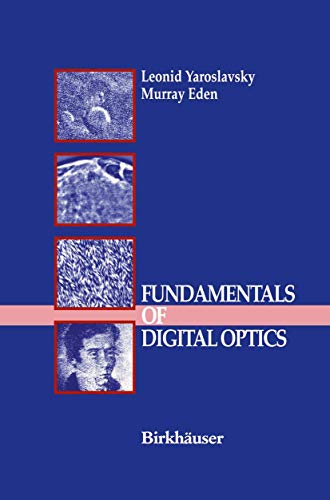Articoli correlati a Fundamentals of Digital Optics: Digital Signal Processing...

Sinossi
1.1 Digital Optics as a Subject Improvement of the quality of optical devices has always been the central task of experimental optics. In modern terms, improvements in sensitivity and resolution have equated higher quality with greater informational throughput. For most of today's applications, optics and electronics have, in essence, solved the problem of generating high quality pictures with great informational ca pacity. Effective use of the enormous amount of information contained in the images necessitates processing pictures, holograms, and interferograms. The manner in which information might be extracted from optical entities has be come a topic of current interest. The informational aspects of optical signals and systems might serve as a basis for attacking this question by making use of information theory and signal communication theory, and by enlisting modern tools and methods for data processing (the most important and powerful of which are those of digi tal computation). Exploiting modern advances in electronics has allowed new wavelength ranges and new kinds of radiation to be used in optics. Comput ers have extended our knowledge of the informational essence of radiation. Thus, computerized optical devices enhance not only the optical capabilities of sight, but also its analytical capabilities as well, thus opening qualitatively new horizons to all the areas in which optical devices have found application.
Le informazioni nella sezione "Riassunto" possono far riferimento a edizioni diverse di questo titolo.
Contenuti
1 Introduction.- 2: Elements of Signal Theory.- 3: Digital Representation of Optical Signals.- 4: Digital Representation of Signal Transformations.- 5: Efficient Computational Procedures for Digital Filtering..- 6: Discrete Orthogonal Transforms and Fast Algorithms in a Matrix Representation.- 7: Digital Statistical Simulation and Measurements.- 8: Linear and Rank Adaptive Filters for Picture Processing..- 9: Adaptive Linear Filters for Objects Localization in Pictures.- 10: Synthesis of Holograms.
Product Description
Book by Yaroslavsky Leonid Eden Murray
Le informazioni nella sezione "Su questo libro" possono far riferimento a edizioni diverse di questo titolo.
EUR 42,00 per la spedizione da Germania a U.S.A.
Destinazione, tempi e costiCompra nuovo
Visualizza questo articoloEUR 3,42 per la spedizione in U.S.A.
Destinazione, tempi e costiRisultati della ricerca per Fundamentals of Digital Optics: Digital Signal Processing...
Fundamentals of Digital Optics
Da: Books Puddle, New York, NY, U.S.A.
Condizione: New. pp. 372. Codice articolo 26457709
Quantità: 1 disponibili
Fundamentals of Digital Optics
Da: Majestic Books, Hounslow, Regno Unito
Condizione: New. pp. 372 52:B&W 6.14 x 9.21in or 234 x 156mm (Royal 8vo) Case Laminate on White w/Gloss Lam. Codice articolo 7423026
Quantità: 1 disponibili
Fundamentals of Digital Optics
Da: Biblios, Frankfurt am main, HESSE, Germania
Condizione: New. pp. 372. Codice articolo 18457703
Quantità: 1 disponibili
Fundamentals of Digital Optics - Digital Signal Processing in Optics and Holography
Da: Basi6 International, Irving, TX, U.S.A.
Condizione: Brand New. New. US edition. Expediting shipping for all USA and Europe orders excluding PO Box. Excellent Customer Service. Codice articolo ABEJUNE24-129863
Quantità: 1 disponibili
Fundamentals of Digital Optics - Digital Signal Processing in Optics and Holography
Da: Romtrade Corp., STERLING HEIGHTS, MI, U.S.A.
Condizione: New. This is a Brand-new US Edition. This Item may be shipped from US or any other country as we have multiple locations worldwide. Codice articolo ABNR-85970
Quantità: 1 disponibili
Fundamentals of Digital Optics: Digital Signal Processing in Optics and Holography
Da: Best Price, Torrance, CA, U.S.A.
Condizione: New. SUPER FAST SHIPPING. Codice articolo 9780817638221
Quantità: 2 disponibili
Fundamentals of Digital Optics : Digital Signal Processing in Optics and Holography
Da: GreatBookPrices, Columbia, MD, U.S.A.
Condizione: New. Codice articolo 207065-n
Quantità: Più di 20 disponibili
Fundamentals of Digital Optics: Digital Signal Processing in Optics and Holography
Da: ALLBOOKS1, Direk, SA, Australia
Codice articolo SHUB129863
Quantità: 1 disponibili
Fundamentals of Digital Optics: Digital Signal Processing in Optics and Holography
Da: Lucky's Textbooks, Dallas, TX, U.S.A.
Condizione: New. Codice articolo ABLIING23Feb2416190237380
Quantità: Più di 20 disponibili
Fundamentals of Digital Optics: Digital Signal Processing in Optics and Holography
Da: Buchmarie, Darmstadt, Germania
Condizione: Good. Ehemaliges Bibliotheksexemplar. Mit Bibliotheksstempel und Aufkleber am Buchrücken. Als übereignet gekennzeichnet. Codice articolo 2853552_e1a
Quantità: 1 disponibili

